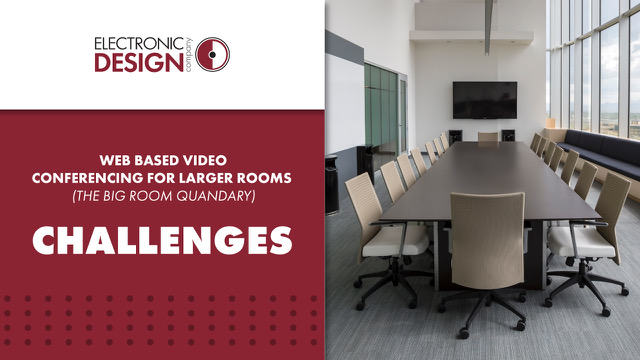
Web Based Video Conferencing for Larger Rooms (The Big Room Quandary): Challenges
August 10, 2021We live in an age where video conferencing is a fact of life for work, school, or even just keeping in touch with family and friends. Although many of us are working from home, there are many businesses that have on site staff that rely on video conferencing from larger sized conference or board rooms, often to those very people working remotely. As the cost of web-based conferencing has plummeted this type of system has become ubiquitous. But trying to make a system designed for your laptop work in a big room poses many challenges. In this series we will try and address some of the issues that users in larger rooms run into while trying to make a positive experience for their group.
There are many things that contribute to a successful video conferencing experience. At the top of that list are internet bandwidth and data transfer efficiency which basically translates into speed. It wasn’t too long ago that our network connections didn’t include broadband straight into our homes. An internet connection meant going through a fairly slow modem. If you wanted to see video, you would have to wait painfully for a progress bar to fill up before you could watch anything. Any kind of peer-to-peer video communication was impractical. So larger businesses would pay for a faster connection to accommodate the desire for conferencing between offices. This would be accomplished by integrating a hardware codec (short for “coder/decoder”) into an audiovisual system including cameras, microphones, control systems and different sorts of processing. They were typically expensive and unless the user was familiar with the codec operation, it could be complicated to control. A combination of high-speed internet connections, more efficient codecs, along with much faster, and more efficient processors, now make it possible to accomplish these tasks in laptops and personal devices using software. This is often called a “soft” codec. The big benefit of a hardware codec is that it is designed to connect and integrate other systems into its functionality. Soft codecs were designed to work with plug-and-play consumer friendly devices and not necessarily integrate easily into professional grade cameras and audio systems without a bunch of hardware configuration, software or driver installation, and other challenges.
So, what can we do to make it work? The best way is to start treating your conference room the same way whether it is running a simple Zoom meeting or a fancy hardware codec with all sorts of devices attached. With some tweaks of the system to address the shortcomings of a soft codec, you can get an excellent user experience. As this series progresses, we will cover a few approaches to make this happen and hopefully answer some common questions along the way.
NEXT INSTALLMENT: Room Acoustics


